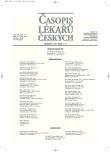Epidemiology of Peripheral Arterial Occlusive Disease
Authors:
M. Chochola; A. Linhart
Authors‘ workplace:
II. interní klinika kardiologie a angiologie 1. LF UK a VFN, Praha
Published in:
Čas. Lék. čes. 2006; 145: 368-370
Category:
Review Article
Overview
The most serious problem in angiology is peripheral arterial occlusive disease. The prevalence of this disease is 2 % in men under 50 years of age and 5 % in men over 70 years of age. Women reach the same numbers approximately 10 years later. The most serious consequence is that in many cases patients with PAOD have also coronary disease and ischemic brain disease. The most common cause of death in patients with PAOD is coronary artery disease (40–60 %); ischemic stroke develops as a cause of death in 10-20% of the patients. About 20-30% of the patients die due to noncardiac factors.
Key words:
peripheral occlusive disease, incidence, prevalence, atherosclerosis.
Labels
Addictology Allergology and clinical immunology Angiology Audiology Clinical biochemistry Dermatology & STDs Paediatric gastroenterology Paediatric surgery Paediatric cardiology Paediatric neurology Paediatric ENT Paediatric psychiatry Paediatric rheumatology Diabetology Pharmacy Vascular surgery Pain management Dental HygienistArticle was published in
Journal of Czech Physicians

Most read in this issue
- Buerger’s Disease
- Vascular Involvement in Thoracic Outlet Syndrome
- Superior Vena Cava Syndrome – Potential of the Intervention Therapy
- NGAL-Neutrophil Gelatinase Associated Lipocalin in Biochemistry, Physiology and Clinical Praxis
